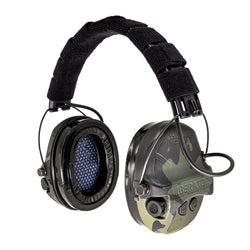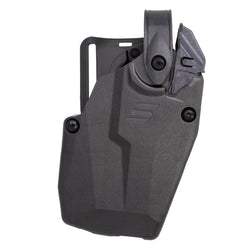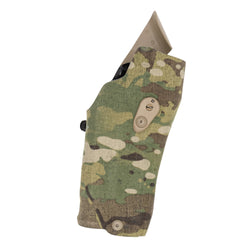Ask any serious shooter for their favorite rifle platform, and you’re bound to start a fight. Albeit a friendly one. Probably.
It’s a debate that’s rooted in philosophy, personal history, and what kind of situation you’re training for. But in the world of shooting sports and self-defense, a great rifle is only half the story.
Having the perfect sidearm can make or break your kit, giving you that crucial backup, that close-quarters utility, or just that feeling of being fully prepared. It’s about building a complementary system, where the rifle and handgun are two halves of a seamless whole.
Synergy, we’ll call it. As much as I hate that term.
I’m a firm believer that the best combos cover multiple needs and use cases, from competition to casual range days to the dreaded “SHTF” scenario.
For clarity, I’m talking about purpose-built pairings rather than pretty aesthetics (although those matter sometimes, too). The combos that earn a spot in your safe are the ones that are easy to deploy, share simple reloading mechanics, and complement each other well in terms of firepower, capacity, and practical application.
That said, let’s pull back the curtain a bit and discuss my three most effective and enjoyable rifle and handgun pairings, diving into the specifics of my optics choices, holster setups, and the ever-present issue of ammo availability. Prepare to be educated, entertained, and maybe even a little jealous. Maybe.
Let’s get into it.
Glock 19 and AR-15: Modern Utility Duo
This first, and probably most obvious, pairing is a modern classic and a must-have for any gun safe: the AR-15 and Glock 19. It’s the combination that screams “do-anything, go-anywhere.” It’s comprised of two platforms that consistently take a beating yet refuse to quit. And, it’s easily the most customizable. Double win.
The Handgun: Glock 19 (or “Gucci” Clone) in 9mm Luger
The Glock 19 is the benchmark for a reason. It strikes that rare balance between concealability and shootability. It’s compact enough for daily carry, yet large enough to handle like a full-size pistol. Chambered in the ever-common 9mm Luger cartridge, it checks nearly every box for reliability, recoil control, and ammunition availability.

Whether it’s bone-stock from the factory or a high-end “Gucci” build like the Shadow Systems MR920, the 9mm Glock platform has earned its reputation not just through marketing hype, but through decades of real-world use by military, law enforcement, and civilians alike.
Ample Aftermarket Support
Aftermarket support is basically limitless (even after Glock’s recent model announcement), which translates to an endless supply of premium parts and other custom options to tailor it for duty, carry, or range use.
Holster options are just as plentiful. Safariland alone offers a lineup deep enough to satisfy everyone from uniformed officers to appendix carry enthusiasts.
Their 6360 ALS/SLS Mid-Ride remains one of the most trusted duty holsters on the market, combining solid retention with smooth draws. On the concealed side, the Incog X IWB (my personal pick) offers a perfect blend of comfort and accessibility, while the newer SOLIS ALS OWB bridges the gap between tactical and practical.
Whether you’re mounting to a belt, chest rig, or quick-detach platform, there’s a Safariland holster for you.

And then there’s the fact that it’s chambered in 9mm Luger, which is the undisputed king of availability and affordability. It’s sold everywhere from your local gun shop to big-box stores to online retailers like Ammo to Go. Training ammo is inexpensive enough to buy by the case without guilt, and premium defensive loads like Speer Gold Dot, Federal HST, and Hornady Critical Duty are consistently in stock.
Honestly, it’s a bit of a no-brainer.
The Rifle: American Defense UIC Mod 1 AR-15
My chosen rifle for this combo is an American Defense UIC Mod 1, a mid-tier AR-15. The AR-15 is the modern sporting rifle baseline for a reason. It shoulders comfortably, points naturally, and scales from varmint-and-range duties to hard-use defensive roles without breaking a sweat.
My specific setup is tuned for dynamic shooting and fast transitions. Up top, I run a 1-6x Vortex Strike Eagle Low Power Variable Optic (LPVO), a low-power variable that gives you the speed of a red dot at close range and usable magnification when you need to push out and place shots at moderate distances. At 1x magnification, it behaves like a reflex sight for instinctive, both-eyes-open work. But if I crank up the magnification, I can maximize precision at longer distances without swapping optics. It’s a workhorse optic that complements the AR-15’s versatility.

But for true CQB performance, I’ve coupled the LPVO with a Vortex Defender XL backup red dot on a 45-degree offset mount. A quick cant of the rifle transitions you from a magnified optic to an unmagnified red dot, bypassing the need to dial down your LPVO. In practical use, the offset red dot is the go-to for true CQB work and rapid target transitions where making even small magnification changes would be too slow.
The AR-15 is a rock-solid platform. I guess they call it “America’s Rifle” for a reason.
Why They Complement Each Other
The synergy between the Glock 19 and this AR-15 setup is obvious when you think in terms of capability and logistics.
Operationally, the AR-15 offers exceptional reach, higher velocities, and improved sight-picture options that simply can’t be matched by a pistol. The Glock 19, on the other hand, is the compact, fast, and convenient backup that’s easy to carry and manipulate in tight spaces. The LPVO and offset red dot combo mirrors that same versatility at the rifle level, while the Glock covers mobility and convenience when a rifle would be overkill.
From a practical standpoint, they reinforce each other. You can train on the same kinds of sighting concepts (dot on target, trigger control, reloads) across both platforms, and both systems are cheap enough to feed that regular practice is affordable.
Honestly, you just can’t go wrong here.
1911 and the M1A Scout Squad: Battle-Proven Heavy Hitters
This combination is a nod to history, a testament to raw, heavy-hitting power, and an aesthetic that just doesn’t quit. This is the duo for the shooter who appreciates the classics and wants to feel like they’re carrying a piece of military history. It’s not about lightweight practicality so much as presence, momentum, and the satisfying mechanical sexiness of those more classic designs.
The Handgun: Government Model 1911 in .45 ACP
The Government Model (full-size) 1911 in .45 ACP, like my no-frills Springfield Armory Mil-Spec 1911, isn’t just a handgun; it’s a true American icon designed by none other than the legendary John Browning. And for shooters who like gear with a story (and proven reliability), that lineage matters.

From the moment the checkered walnut (or faux-walnut) grips settle into your hand and the single-action trigger breaks clean and deliberate, you get why this gun has endured the test of time. It’s heavy, yet balanced, and unapologetically simple. It’s a classic that simply feels badass to carry.
That said, a good 1911 rewards consistent maintenance and quality parts. Lucky for us, aftermarket support is mature and plentiful. High-end manufacturers like Nighthawk Custom have refined feeding geometries, tuned extractors, and mags that make feeding the beefy .45 cartridge reliable even under sustained use.
Holster and carry choices lean traditional. Leather holster options, such as shoulder platforms, pancake-style OWB rigs, pair beautifully with the silhouette and weight of a Government 1911. If you want modern retention and duty-ready bodies, Safariland’s 6280 SLS series offers practical solutions for 1911 variants, including models with accessory rails.
As with any handgun, the important thing is to match your preferred holster type to your role.
Regardless, the Government 1911 in .45 ACP is equal parts heritage, ergonomics, and a platform that rewards thoughtful upkeep. If that tickles your fancy, it’s a hell of a companion to carry and shoot.
The Rifle: Springfield M1A Scout Squad in .308 Win/7.62x51mm NATO
The M1A lineage traces directly to the M14 and brings full-power rifle performance in a package that still feels classic. The Scout Squad is a modern, compact take, complete with a shorter barrel, a forward rail for scout optics, and a proprietary muzzle brake that helps control the recoil of a full-power .308 round.
Optic choices here are intentional. Scout-style mounting calls for a low-power, long-eye-relief scope. Something like the Vortex Crossfire II 2–7x in the forward position that keeps the receiver clear for ejection and preserves a natural point of aim.
But beyond that, aesthetics truly matter with this gun. The wooden stock, the classic lines, and the weight all play into the experience of carrying a true All-American rifle that has more than earned its keep. And while it is a gorgeous gun, don’t be fooled into thinking it’s just a safe queen or conversation starter.

No. The platform is remarkably effective for target work, ranching, and hunting applications where penetration and range matter. Shoot, it still sees use in combat with specialized American warfare units. There’s something to be said for that, too.
At the end of the day, the Scout Squad is a living, breathing evolution of a proven battle rifle that’s aged entirely too well. The short barrel, forward optic rail, and muzzle brake turn a full-power .308 into something surprisingly manageable and versatile, and when you pair the right glass and ammo, it’s equally at home on a ranch, at the range, or in the field.
Why They Complement Each Other
As I mentioned earlier, this combo is for the lover of battle-proven legacy and military history. Both platforms offer a timeless look, a heavy-duty feel, and deliver potent terminal performance with their respective big-bore cartridges.
And while .308 Win/7.62 NATO ammo is pricier and heavier to carry than America’s favorite cartridge — the 5.56x45mm NATO — it delivers a massive advantage in range and energy on target, perfectly complementing the punchy .45 ACP sidearm.
Put simply, this duo is less about redundancy and more about complementary roles that share a common temperament: they’re heavy hitters that reward deliberate, practiced use. Nuff said.
Beretta CX4 Storm and Beretta 92FS/M9: Shared Platform Simplicity
This final pairing is the ultimate lesson in practical commonality. A pistol-caliber carbine (PCC) that takes the same magazines as its sibling pistol gives you an advantage that’s entirely too easy to exploit: one ammo type, one magazine platform, and a “parallel” training regimen.
For shooters who prize straightforward, mission-focused kit, the Beretta CX4 Storm paired with the Beretta 92FS/M9 is just too cool to pass up. Seriously. It’s a match made in heaven.
The Handgun: Beretta 92FS/M9
The Beretta 92FS, or its military M9 counterpart, is an Italian-made icon with a storied military service history. It is unmistakable in both its silhouette and its reputation. It’s a large-frame, double-action/single-action design that points well, tracks cleanly, and has an ergonomics package that many shooters find immediately natural. Accuracy, reliability, and service-proven durability are the pillars of its appeal.
And in my opinion, it is a nearly perfect handgun. It’s reliable, beautifully balanced, and notorious for its excellent accuracy.

For those who love an Outside-the-Waistband (OWB) setup, Safariland offers a variety of duty and tactical holsters, such as the 6378 ALS Low-Signature holster for the 92FS/M9. Granted, the Beretta’s size makes it less ideal for deep concealment, but it’s an excellent duty or home-defense tool. Plus, like the Glock 19, the 92FS is chambered in 9mm Luger, which is both widely available and affordable for bulk training and target practice.
All told, the 92FS/M9 is the kind of service-proven, shootable platform that makes sense for anyone who wants a full-size, confidence-inspiring 9mm. It points and tracks like a handgun that was meant to be shot, eats cheap range ammo by the box, and cleans up easily when the day’s done.
Its size and weight push it toward OWB/duty use or home defense rather than deep concealment, but if you want something that feels deliberate in your hand and runs reliably while delivering that classic Italian design with an American service record to back it up, it’s hard to beat.
The Rifle: Beretta CX4 Storm PCC
The Beretta CX4 Storm is one of the most distinctive and under-appreciated PCCs on the market. It’s incredibly fun and accurate, but it’s also incredibly light-recoiling, easy to point, and absurdly controllable compared to full-power rifles.
My current setup is the base model, topped with a simple yet effective Vortex Sparc II red dot. The beauty of the CX4 is that it doesn’t need to be heavily tricked out.

It comes with a slide-out front rail for a light or bipod, and its ergonomics are outstanding. The easy-to-use fire controls are ambidextrous, and the reversible charging handle makes it a great choice for nearly any shooter, regardless of their dominant hand.
But most importantly, the CX4 accepts Beretta 92-series magazines natively, which is really the whole point of this combo. I can run the 92FS’s standard magazine, or one of the longer 25-round Beretta-factory 92-series magazines in the carbine, adding serious capacity without having to carry an extra set of mags for my sidearm. The result, then, is a lighter load on my belt and faster transitions between weapons.
It’s a ridiculously effective truck, home-defense, or range rig that’s fun to shoot and easy to maintain. It doesn’t get much better than that.
Why They Complement Each Other
This is the very definition of a match made in heaven for a target shooter, home defense enthusiast, or prepper. Not because it’s flashy, but because it’s stupid-practical.
You need only buy one type of ammo, and all your magazines can be used in either gun. That alone cuts cost, hassle, and the chance of fumbling a reload or confusing mag types under stress. Swap a 25-round Beretta mag from your pistol into the CX4 and you instantly gain rifle-like control and sustained capacity without changing your logistics or training.
Honestly, if you want a compact, high-capacity, money-smart setup that’s also a ton of fun to shoot, this combo is hard to beat. The 92FS is a stellar sidearm, while the CX4 Storm provides the stability, velocity increase, and magazine capacity of a rifle platform. It’s truly a perfect pairing that shoots well and feels good in the hand.
Pair Up!
Choosing a rifle and handgun combo is less about trends or brand loyalty and more about balance. You’re matching guns that cover each other’s weaknesses, making you a more capable shooter overall.
Maybe you lean toward the modern practicality of the AR-15 and Glock 19, the timeless muscle of the M1A Scout Squad and 1911, or the shared-caliber efficiency of the CX4 Storm and 92FS. Or maybe you’ve got an idea for a combination of your own. Whatever the pairing, each has its own strengths, quirks, and specific training demands. And all of them reward time on the range and a thoughtful setup.
Regardless, the point of the complementary handgun/rifle combination is to work as a system. And that system-level thinking pays off with simpler training, improved cost management, and more field efficiency. That is to say that focusing on handguns and rifles that truly complement one another allows you to spend less time stressing over gear and more time training.
Pick the pair that matches how you shoot and what you train for, and you’ll spend less time worrying about your kit and more time actually putting your training to the test. Remember that price tags and shiny, feature-packed heat pieces don’t always translate to practicality. And at the end of the day, practicality always wins in a gun fight. So, which combo are you building first?









